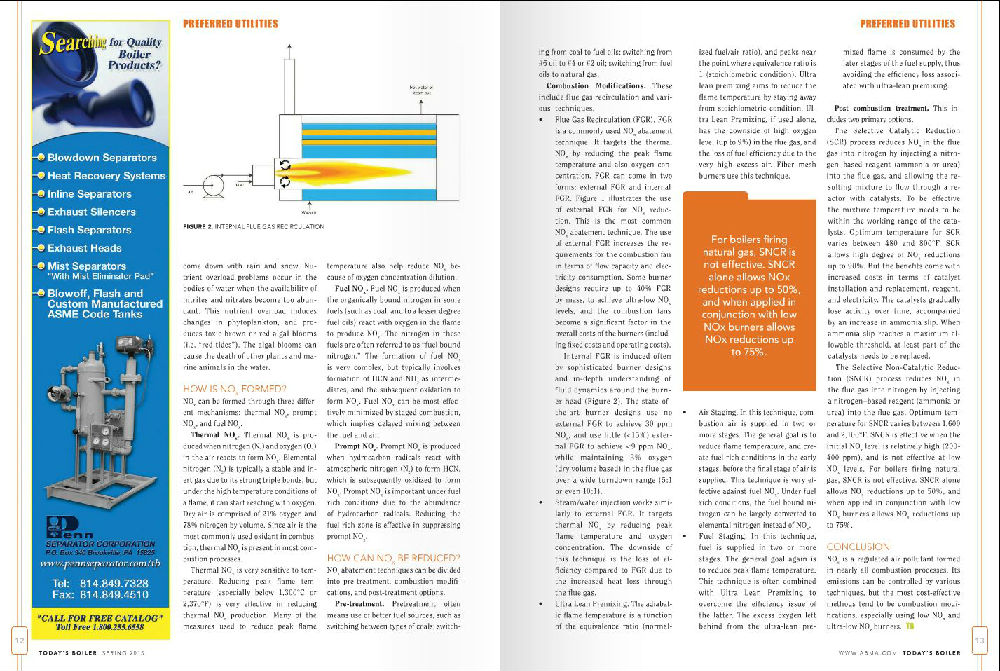博文
NOx Emissions: Reduction Strategies
||||
NOx Emissions: Reduction Strategies
Published May 2015 “Today's Boiler"
The article, written by Dr. Jianhui Hong,begins on page 10.
点击这里,可以看到整本彩色杂志,我的文章从第十页开始:
Click here: http://digital.bnpmedia.com/publication/?i=256332
If you operate stationary fired equipment (such as a boiler) and you are concerned about compliance to emission regulations, you may find this article useful. It provides a basic primer on a class of regulated pollutants called Nox and methods for controlling and minimizing their emissions.
WHAT IS NOX?
Nox is a term used to include two important air pollutants: NO (nitric oxide) and NO2 (nitrogen dioxide). These pollutants are sometimes called mono-nitrogen oxides. In contrast, the generic term "nitrogen oxides" includes a family of seven different chemical compounds (NO, NO2, N2O, N2O2, N2O3, N2O4, N2O5). Nox should not be confused with N2O (laughing gas), an analgesic commonly used in dental operations. Nox is formed and emitted in nearly all combustion processes.
WHY IS NOX BAD FOR HUMAN HEALTH AND THE ENVIRONMENT?
NO and NO2 are harmful to human health in their own rights. But they also play some indirect roles in harming human health and the environment.
NO is a colorless, poisonous, oxidizing gas with an irritating odor. NO is toxic by inhalation, and symptoms of overexposure may not become apparent for up to 72 hours. Exposure to NO gas in low concentrations produces an irritating effect on the mucous membranes of the eyes, nose, throat and lungs, which can include choking, coughing, headache, nausea, and fatigue.
NO2 is a reddish brown, poisonous gas with a slightly irritating odor. Because it is relatively insoluble in water, there is little irritation to the mucous membranes of the eyes, nose, and throat. Therefore, people who inhale even high concentrations may not be aware of their exposure. This allows NO2 to penetrate well into the lungs, where it causes oxidizing damage to the tissues.
Acid rain. Nox can react with water or water vapor to form nitrous acid (HNO2) and nitric acid (HNO3). These acids in the rain can make "acid rain." Acid rain can damage plants and man-made structures such as buildings, bridges, and outdoor sculptures.
Smog/Ground level ozone. Nox emissions from combustion processes are primarily in the form of NO. In the air,NO reacts with oxygen to produce NO2. In the presence of sunlight, Nox can react with hydrocarbons, especially VOC (volatile organic compounds) in the air to form ground-level ozone, which is an important ingredient of smog. The reddish brown color of the hazes hanging over the skies of some major cities comes from NO2 gas. Ground level ozone is also a health hazard. It can cause irritation to eyes, noses, throats, and lungs. It can even cause asthma and other chronic lung diseases such as emphysema and chronic bronchitis.
In the air, nitrous acid (HNO2) and nitric acid (HNO3) from the combination of Nox and water vapor can react with ammonia to form nitrite and nitrate salt crystals (NH4NO2 and NH4NO3). Together with sulfates, sulfites and organic particles, these nitrites and nitrates can make up 90% of Particulate Matter less than 2.5 microns in aerodynamic diameter (PM2.5). The PM2.5 interferes with the transmission of sunlight in the air, and causes visibility issues in the form of a haze that, unlike a fog, does not clear when the air warms up.
Water Quality - Nutrient Overload. Nox can form nitrates in the air as we discussed. These nitrates can then come down with rain and snow. Nutrient overload problems occur in the bodies of water when the availability of nitrites and nitrates become too abundant. This nutrient overload induces changes in phytoplankton, and produces toxic brown or red algal blooms (i. E. "red tides"). The algal blooms can cause the death of other plants and marine animals in the water.
HOW IS NOX FORMED?
Nox can be formed through three different mechanisms: thermal Nox, prompt Nox, and fuel Nox.
Thermal Nox. Thermal Nox is produced when nitrogen (N2) and oxygen (O2) in the air reacts to form Nox. Elemental nitrogen (N2) is typically a stable and inert gas due to its strong triple bonds, but under the high temperature conditions of a flame, it can start reacting with oxygen. Dry air is comprised of 21% oxygen and 78% nitrogen by volume. Since air is the most commonly used oxidant in combustion, thermal Nox is present in most combustion processes.
Thermal Nox is very sensitive to temperature. Reducing peak flame temperature (especially below 1,300°C or 2,370°F) is very effective in reducing thermal Nox production. Many of the measures used to reduce peak flame temperature also help reduce Nox because of oxygen concentration dilution.
Fuel Nox. Fuel Nox is produced when the organically bound nitrogen in some fuels (such as coal, and to a lesser degree fuel oils) react with oxygen in the flame to produce Nox. The nitrogen in these fuels are often referred to as "fuel bound nitrogen." The formation of fuel Nox is very complex, but typically involves formation of HCN and NH3 as intermediates, and the subsequent oxidation to form Nox. Fuel Nox can be most effectively minimized by staged combustion, which implies delayed mixing between the fuel and air.
Prompt Nox. Prompt Nox is produced when hydrocarbon radicals react with atmospheric nitrogen (N2) to form HCN, which is subsequently oxidized to form Nox. Prompt Nox is important under fuel rich conditions due to the abundance of hydrocarbon radicals. Reducing the fuel rich zone is effective in suppressing prompt Nox.
HOW CAN NOX BE REDUCED?
Nox abatement techniques can be divided into pre-treatment, combustion modifications, and post-treatment options.
Pre-treatment. Pretreatment often means use of better fuel sources, such as switching between types of coals; switch-ing from coal to fuel oils; switching from #6 oil to #4 or #2 oil; switching from fuel oils to natural gas.
Combustion Modifications. These include flue gas recirculation and various techniques.
Flue Gas Recirculation (FGR). FGR is a commonly used Nox abatement technique. It targets the thermal Nox by reducing the peak flame temperature and also oxygen concentration. FGR can come in two forms: external FGR and internal FGR. Figure 1 illustrates the use of external FGR for Nox reduction. This is the most common Nox abatement technique. The use of external FGR increases the requirements for the combustion fan in terms of flow capacity and electricity consumption. Some burner designs require up to 40% FGR by mass, to achieve ultra-low Nox levels, and the combustion fans become a significant factor in the overall costs of the burners (including fixed costs and operating costs).
Internal FGR is induced often by sophisticated burner designs and in-depth understanding of fluid dynamics around the burner head (Figure 2). The state-ofthe- art burner designs use no external FGR to achieve 30 ppm Nox, and use little (<15%) external FGR to achieve <9 ppm Nox, while maintaining 3% oxygen (dry volume based) in the flue gas over a wide turndown range (5:1 or even 10:1).
.Steam/water injection works similarly to external FGR. It targets thermal Nox by reducing peak flame temperature and oxygen concentration. The downside of this technique is the loss of efficiency compared to FGR due to the increased heat loss through the flue gas.
Ultra Lean Premixing. The adiabatic flame temperature is a function of the equivalence ratio (normalized fuel/air ratio), and peaks near the point where equivalence ratio is 1 (stoichiometric condition). Ultra lean premixing aims to reduce the flame temperature by staying away from stoichiometric condition. Ultra Lean Premixing, if used alone, has the downside of high oxygen level (up to 9%) in the flue gas, and the loss of fuel efficiency due to the very high excess air. Fiber mesh burners use this technique.
Air Staging. In this technique, combustion air is supplied in two or more stages. The general goal is to reduce flame temperature, and create fuel rich conditions in the early stages, before the final stage of air is supplied. This technique is very effective against fuel Nox. Under fuel rich conditions, the fuel bound nitrogen can be largely converted to elemental nitrogen instead of Nox.
Fuel Staging. In this technique, fuel is supplied in two or more stages. The general goal again is to reduce peak flame temperature. This technique is often combined with Ultra Lean Premixing to overcome the efficiency issue of the latter. The excess oxygen left behind from the ultra-lean premixed flame is consumed by the later stages of the fuel supply, thus avoiding the efficiency loss associated with ultra-lean premixing.
Post combustion treatment. This includes two primary options.
The Selective Catalytic Reduction (SCR) process reduces Nox in the flue gas into nitrogen by injecting a nitrogen- based reagent (ammonia or urea) into the flue gas, and allowing the resulting mixture to flow through a reactor with catalysts. To be effective the mixture temperature needs to be within the working range of the catalysts. Optimum temperature for SCR varies between 480 and 800°F. SCR allows high degree of Nox reductions up to 90%. But the benefits come with increased costs in terms of catalyst installation and replacement, reagent, and electricity. The catalysts gradually lose activity over time, accompanied by an increase in ammonia slip. When ammonia slip reaches a maximum allowable threshold, at least part of the catalysts needs to be replaced.
The Selective Non-Catalytic Reduction (SNCR) process reduces Nox in the flue gas into nitrogen by injecting a nitrogen-based reagent (ammonia or urea) into the flue gas. Optimum temperature for SNCR varies between 1,600 and 2,100°F. SNCR is effective when the initial Nox level is relatively high (200- 400 ppm), and is not effective at low Nox levels. For boilers firing natural gas, SNCR is not effective. SNCR alone allows Nox reductions up to 50%, and when applied in conjunction with low Nox burners allows Nox reductions up to 75%.
CONCLUSION
Nox is a regulated air pollutant formed in nearly all combustion processes. Its emissions can be controlled by various techniques, but the most cost-effective methods tend to be combustion modifications, especially using low Nox and ultra-low Nox burners.


https://m.sciencenet.cn/blog-2470641-893881.html
上一篇:自主品牌汽车的囚徒困境
下一篇:谁说老中没有原创性?我的发明成了热销产品(三)